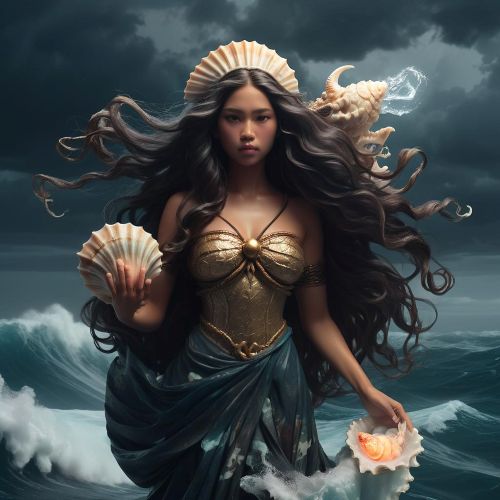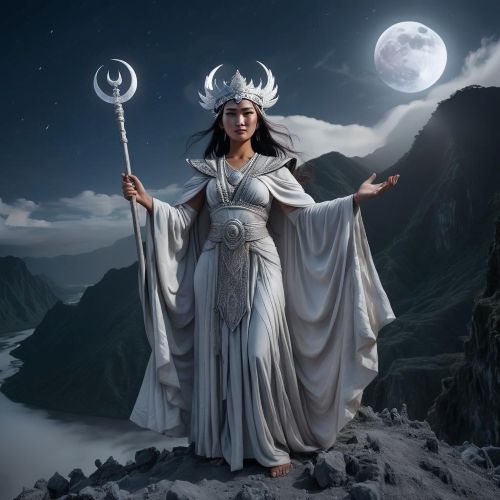Luyong Baybay : Goddess of Tides
Listen
At a glance
| Description | |
|---|---|
| Origin | Philippine Mythology |
| Classification | Gods |
| Family Members | Luyong Kabig (Sister), Paigrab (Husband), Magsanladung Biday )Child) |
| Region | Philippines |
| Associated With | Moon, Tides |
Luyong Baybay
Introduction
Luyong Baybay holds a sacred place in the mythology of the Panay Bukidnon people from the Western Visayas region of the Philippines. Revered as the diwata of the tides, she governs the rhythmic motion of the sea that shapes the lives of coastal communities. Her name, often interpreted as “She who was born from the waves,” reflects her deep bond with the ocean and its mysterious cycles. For generations, her presence was invoked by fisherfolk and villagers who depended on her favor to ensure calm seas and plentiful catches.
Physical Traits
While ancient texts and chants rarely describe Luyong Baybay in detail, oral traditions paint an image of a divine being who embodies the sea’s dual nature—tranquil yet unpredictable. Artists and storytellers imagine her as a graceful woman with flowing hair that mimics the ocean’s tides, often adorned with shells, pearls, and marine motifs. Her aura is said to shimmer like moonlight on water, echoing her rumored ties to celestial bodies. In local legends, she sometimes appears as a solitary maiden by the shoreline during full moons, seductively singing to passing sailors or beckoning those who stray too close.
Family
Luyong Baybay is part of a dynamic pantheon rooted in the cosmology of the Sulodnon people. She is the sister of Luyong Kabig, a guardian spirit who oversees the serpentine streams leading to the underworld. Her consort is Paigrab, a mysterious fire deity or underworld ruler whose presence balances her oceanic dominion. Their daughter, Magsanladung Biday, is believed to guide fishermen through dreams and omens, helping them navigate the seas. In some tales, Luyong Baybay is described as a child of Maklium sa Tubig, a primordial sea god, and is said to be kin to several other nature goddesses, creating a rich genealogical network of elemental forces.
Other names
Though Luyong Baybay is her most well-known name, it also serves as a poetic title that reflects her origin—“born of the sea” or “from the waves.” In other interpretations, she’s referred to as the Goddess of the Tides or even the Moon’s Lover, highlighting her role in influencing ocean currents through her connection to lunar phases. These associations extend her identity beyond the physical realm, situating her as a cosmic force with influence over both time and tide. In some folk traditions, she’s linked to the underworld, suggesting she straddles the realms of life and death—earth and sea—adding further mystique to her identity.
Powers and Abilities
As the diwata governing the tides, Luyong Baybay wields extraordinary control over the ocean. Her primary role is to command the ebb and flow of saltwater, a force that affects daily life, travel, and survival for coastal communities. In myth, she’s not only able to stir calm waters into storms but also summon rogue waves or whirlpools when angered. Her influence is said to intensify during full moons—echoing her love for the moon god Libulan—when tides are at their strongest, as if her yearning for him tugs at the sea itself. Additionally, she can alter sea routes and reveal or conceal mystical places such as Gadlum and Burutlakan-ka-adlaw, realms tied to other deities of darkness and light. She is both protector and punisher, rewarding reverence with abundance and punishing arrogance with peril.
Modern Day Influence
Though the era of diwata worship has faded due to colonial influence and widespread Christianization, Luyong Baybay’s legend endures. Among older generations in Panay, her name is still whispered in stories that teach respect for the sea. In recent years, there’s been a cultural revival of indigenous myths, driven by scholars, artists, and youth reclaiming their heritage. Luyong Baybay has begun to resurface in various forms—her image inspiring paintings, poems, and independent storytelling projects.
In digital media, she has been reimagined for modern audiences, sometimes depicted as a divine figure grappling with longing and heartbreak, especially in LGBTQIA+ interpretations that frame her love for the moon god Libulan as a metaphor for unfulfilled desire. Filipino creators have also used her story to explore themes of environmental stewardship, using her mythos to symbolize the need to protect marine ecosystems. Her representation is evolving into a powerful emblem of indigenous identity, femininity, and environmental balance.
Related Images
Source
Visayan Mythologies of the Philippines. (2013, May 26). Luyong Baybay profile. http://vizayanmyths.blogspot.com/2013/05/luyong-baybay-profile.html
rhysiana. (2017, December 23). Stuff and things — littlestpersimmon: Luyong Baybay, A Philippine…. https://rhysiana.tumblr.com/post/168864703770/littlestpersimmon-luyong-baybay-a-philippine
Fandom. (2025, March 10). Olden Visayan Deity Physiology | Superpower Fanon Wiki. https://superpower-fanon.fandom.com/wiki/Olden_Visayan_Deity_Physiology
Jocano, F. L. (1969). Outline of Philippine Mythology. Manila: Centro Escolar University Research and Development Center.
Philippine Cultural Education Online. (n.d.). Luyong Baybay: Diwata of the tides of the Panay Bukidnon
Frequently Asked Questions
What is lorem Ipsum?
I am text block. Click edit button to change this text. Lorem ipsum dolor sit amet, consectetur adipiscing elit. Ut elit tellus, luctus nec ullamcorper mattis, pulvinar dapibus leo.
What is lorem Ipsum?
I am text block. Click edit button to change this text. Lorem ipsum dolor sit amet, consectetur adipiscing elit. Ut elit tellus, luctus nec ullamcorper mattis, pulvinar dapibus leo.
What is lorem Ipsum?
I am text block. Click edit button to change this text. Lorem ipsum dolor sit amet, consectetur adipiscing elit. Ut elit tellus, luctus nec ullamcorper mattis, pulvinar dapibus leo.
What is lorem Ipsum?
I am text block. Click edit button to change this text. Lorem ipsum dolor sit amet, consectetur adipiscing elit. Ut elit tellus, luctus nec ullamcorper mattis, pulvinar dapibus leo.
What is lorem Ipsum?
I am text block. Click edit button to change this text. Lorem ipsum dolor sit amet, consectetur adipiscing elit. Ut elit tellus, luctus nec ullamcorper mattis, pulvinar dapibus leo.










